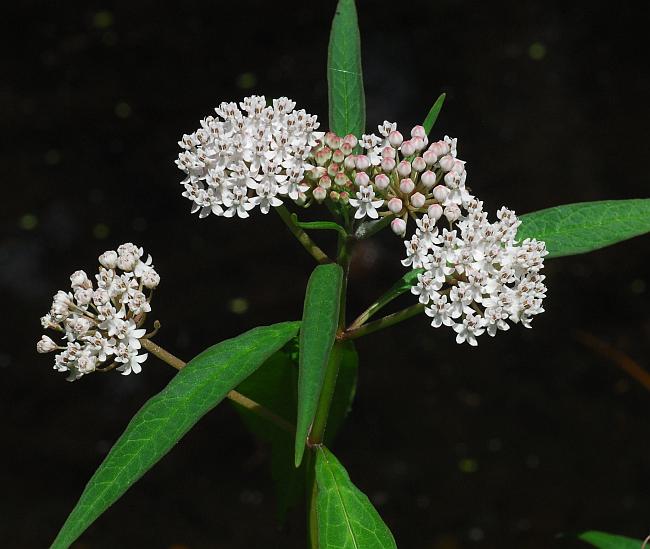Asclepias perennis Walter
White Milkweed

Native
CC = 9
CW = -5
MOC = 12
© SRTurner
Asclepias perennis WalterWhite Milkweed | |
 |
Native CC = 9 CW = -5 MOC = 12 |
© SRTurner |
|
Family - Asclepiadaceae Habit - Perennial forb from a fibrous, sometimes slightly woody rootstock.
Stems - Erect to ascending, to 50 cm, often branched, glabrous or sparsely pubescent in longitudinal lines of antrorse hairs, with 6 to numerous nodes, terete to somewhat compressed.
Leaves - Opposite, petiolate, simple, entire. Petioles to 1.5 cm long, with an adaxial groove formed by decurrent blade tissue, glabrous. Blades to 15 cm long, 3.5 cm wide, narrowly lanceolate to elliptic, dull green above, light-green below, mostly glabrous, bases tapered, pointed at tips. Midrib impressed adaxially, expressed abaxially.
Inflorescence - Umbels, 1-8 per stem, terminal and axillary in upper nodes, stalked, with 8-25 flowers each. Peduncles to 2 cm long, pubescent. Rays of inflorescence subtended by linear bracts. Bracts 2-4 mm long, 1 mm broad, sparsely pubescent. Rays antrorsely pubescent, 1 cm long, light purplish to greenish.
Flowers - Calyx lobes 5, reflexed, sparsely and minutely hairy on the outer surface, 1.0-1.5 mm long, oblong-elliptic. Corolla lobes 5, spreading to reflexed, glabrous, white, sometimes tinged with pale pink, 2.5-4.0 mm long, lanceolate to narrowly elliptic. Gynostegium appearing stalked (the column visible below the bases of the hoods), white, the corona slightly shorter than to about as long as the tip of the anther/stigma head. Corona hoods white, glabrous, 2.0-2.8 mm long, ascending, attached near their bases, oblong-ovate in outline, the tips broadly rounded, the margins not toothed, the bases not pouched. Horns white, attached toward the hood bases, extended conspicuously beyond the tips of the hoods and incurved over the anther/stigma head, linear, not flattened, tapered to a sharp point at the tip. Pollinia total length 1.5mm long. Pollen sacs 1mm long. Terminator dark purple. Pistils 2, glabrous, green, enclosed by and subtending the anther column.
Fruits - Follicles 4-7 cm long, pendent from usually deflexed stalks, ovate to broadly elliptic-ovate in outline, the surface smooth, glabrous. Seeds with the body 12-17 mm long, the margins broadly winged, the terminal tuft of hairs absent.
Flowering - May - September. Habitat - Low, wet woods, cypress swamps, lake and pond margins, slow streams, wet ditches. Origin - Native to the U.S. Other info. - This attractive species occurs in a tight group of counties in the southeastern corner on Missouri. This group is part of a band which runs from Indiana southwest through southeastern Texas, and eastward to South Carolina. The plant can be identified by its low stature and its clusters of bright white flowers. There are several other white-flowered milkweeds in Missouri, but no others have flowers with the pure whiteness of A. perennis. Photographs taken off Hwy 65, Craighead County, AR., 6-12-05 (DETenaglia); also at Duck Creek Conservation Area, Stoddard County, MO, 8-12-2015 and 6-16-2023, and Otter Slough Conservation Area, Stoddard County, MO, 6-26-2019 (SRTurner). |